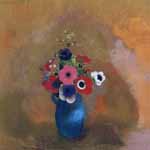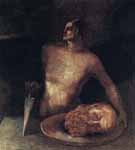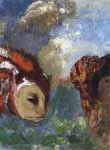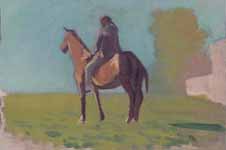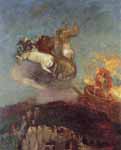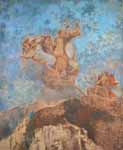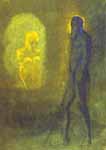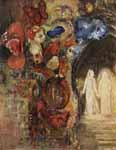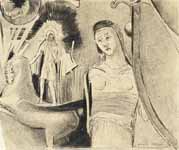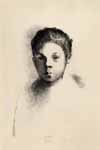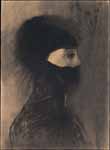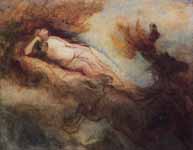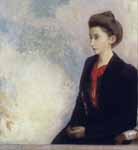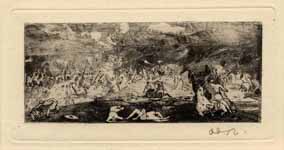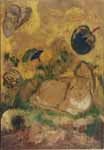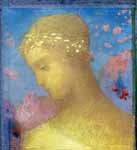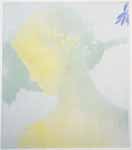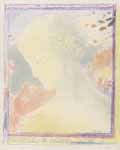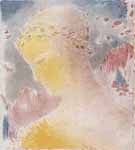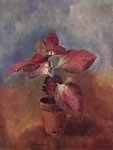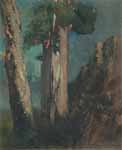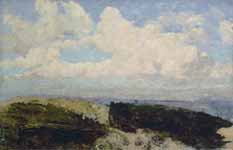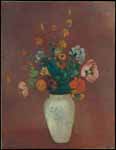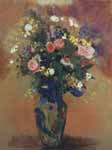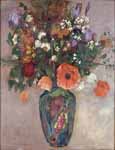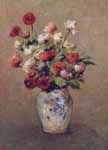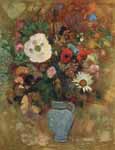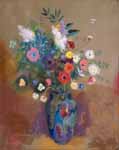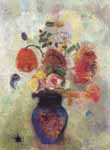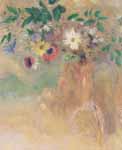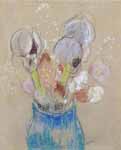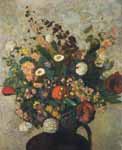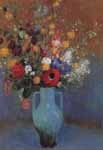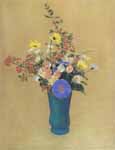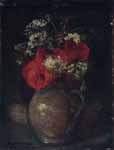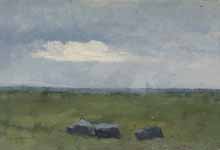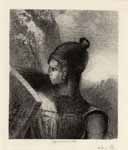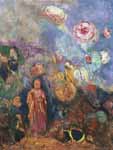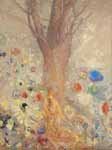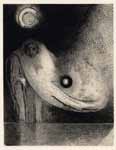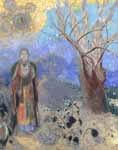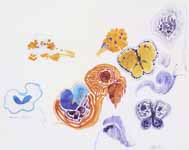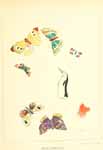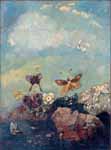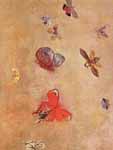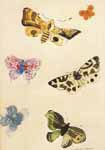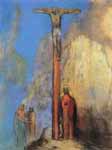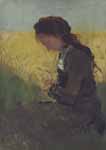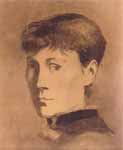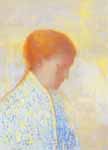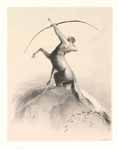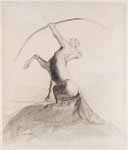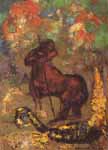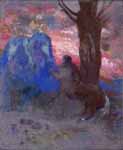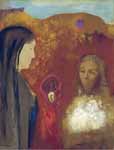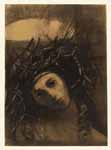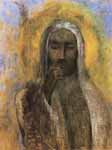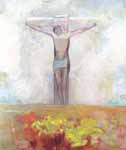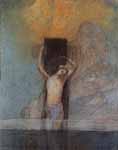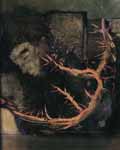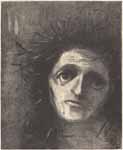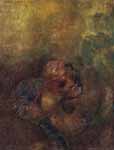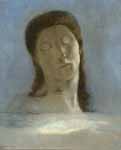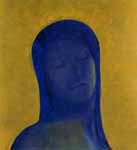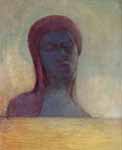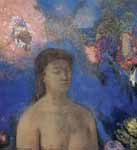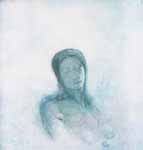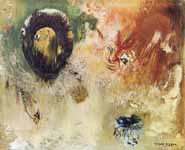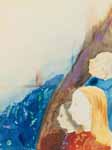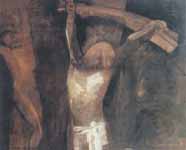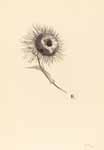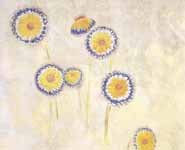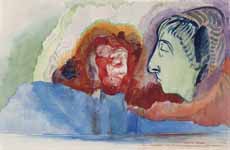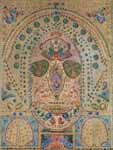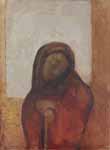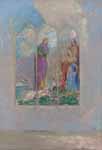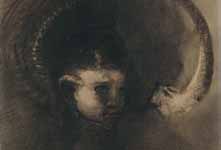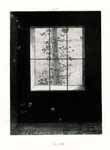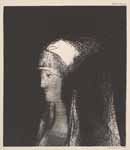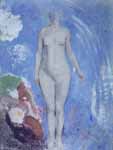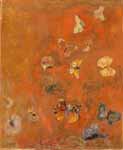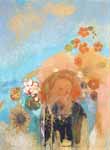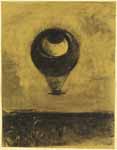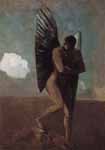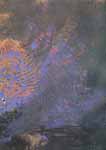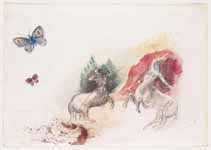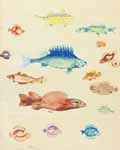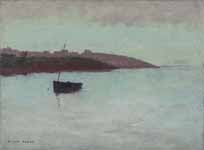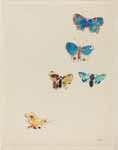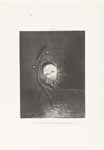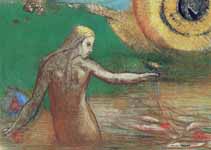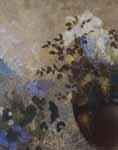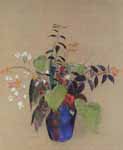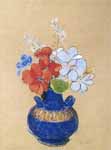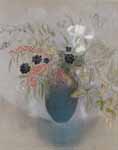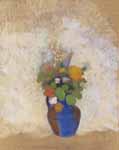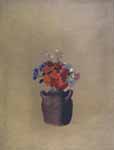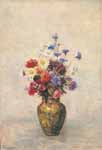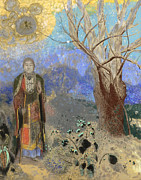Odilon Redon
Odilon Redon : Part 1 : Part 2 : Part 3
Breton Village

A Flying Monster Threatens to Strike with a Wing an Oblivious Person with an Ornate Cap
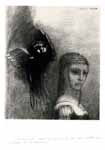
A Fishing Boat (after Eugene Isabey)

A Long Chrysalis, the Color of Blood

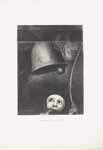
A Mask Sounds the Funeral Knell



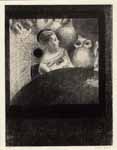
A Woman Seen through a Window Surrounded by Spheres and a Face with Eyes

A.M.R. Bonger - van der Linden
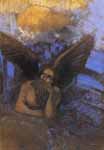
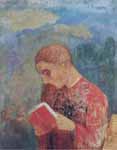
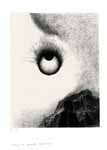
An Eye Floating in the Sky above a Mountain
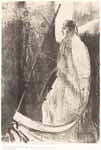
And Another Angel Came out of the Temple Which Is in Heaven, and He also Having a Sharp Sickle
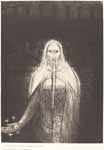
And He Had in His Right Hand Seven Stars, and out of His Mouth Went a Sharp Two-Edged Sword
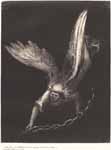

And I Saw in the Right Hand of Him That Sat on the Throne a Book Written within...,
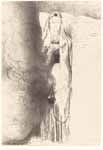
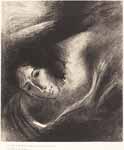
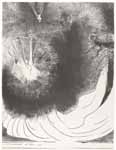
And There Fell a Great Star from Heaven, Burning as It Were a Lamp

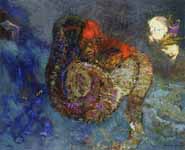

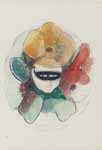
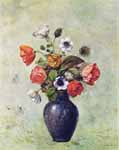
Anemones and Poppies in a Vase
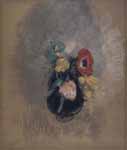
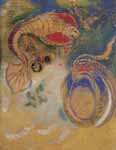 Animals of the Bottom of the Sea
Animals of the Bottom of the Sea
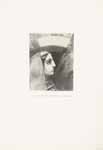 Before the Black Sun of Melancholy, Lenore Appears
Before the Black Sun of Melancholy, Lenore Appears
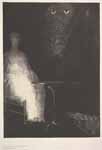 Below, I Saw the Vaporous Contours of a Human Form
Below, I Saw the Vaporous Contours of a Human Form
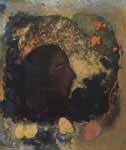 Black Profile (also known as Homage to Gauguin)
Black Profile (also known as Homage to Gauguin)
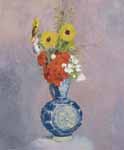 Bouquet of Flowers in a Blue Vase
Bouquet of Flowers in a Blue Vase
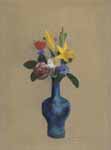 Bouquet of Flowers in a Blue Vase
Bouquet of Flowers in a Blue Vase
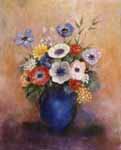 Bouquet of Flowers in a Blue Vase
Bouquet of Flowers in a Blue Vase
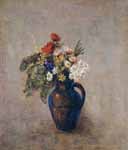 Bouquet of Flowers in a Blue Vase
Bouquet of Flowers in a Blue Vase
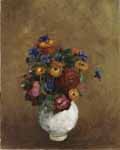 Bouquet of Flowers in a White Vase
Bouquet of Flowers in a White Vase
 Bouquet with White Lilacs in a Japanese Vase
Bouquet with White Lilacs in a Japanese Vase
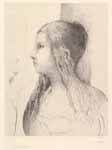 Brunnhilde (The Twilight of the Gods)
Brunnhilde (The Twilight of the Gods)
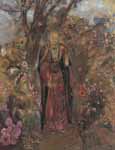 Buddha Walking among the Flowers
Buddha Walking among the Flowers

Bust of a Man Sleeping among the Flowers

 Carnations in the Green Pitcher
Carnations in the Green Pitcher
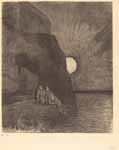 Ceaselessly by My Side the Demon Stirs
Ceaselessly by My Side the Demon Stirs
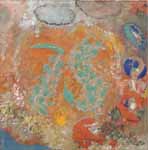 Composition Flowers without a Vase
Composition Flowers without a Vase
 Domecy Decoration The Yellow Flowering Branch
Domecy Decoration The Yellow Flowering Branch
 Domecy Decoration Large Decorative Panel with Floral Decor
Domecy Decoration Large Decorative Panel with Floral Decor
 Domecy Decoration Large Decorative Panel with Floral Decor
Domecy Decoration Large Decorative Panel with Floral Decor
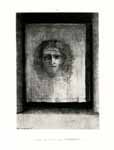 Dreams I. A Veil, a Printed Image
Dreams I. A Veil, a Printed Image
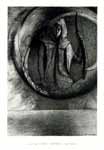 Dreams II. And over There, the Astral Idol, the Apotheosis
Dreams II. And over There, the Astral Idol, the Apotheosis
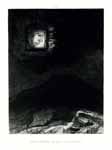 Dreams III. The Vague Glimmer of a Head Suspended in Space
Dreams III. The Vague Glimmer of a Head Suspended in Space
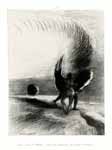 Dreams IV. In the Shadow of the Wing, the Black Creature Bit
Dreams IV. In the Shadow of the Wing, the Black Creature Bit
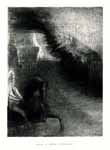 Dreams V. Pilgrim from a Sublunar World
Dreams V. Pilgrim from a Sublunar World
 Evocation (also known as Head of Christ (Inspiration from a Mosaic in Revenna)
Evocation (also known as Head of Christ (Inspiration from a Mosaic in Revenna)
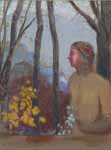 Evocation (Woman at the Mountain)
Evocation (Woman at the Mountain)
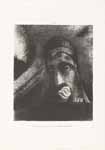 Face of Mystery (In my dream I saw in the Sky a Face of Mystery)
Face of Mystery (In my dream I saw in the Sky a Face of Mystery)
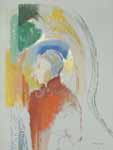

Figure under a Blossoming Tree
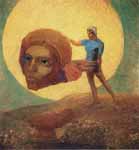

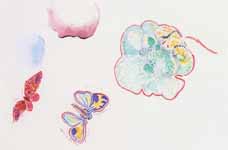 Flower and Butterflies with Profile
Flower and Butterflies with Profile


Flowers in a Pot on a Red Background
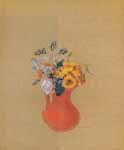
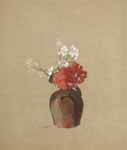
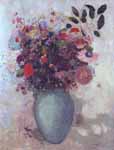

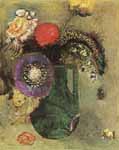 Flowers in Green Vase with Handles
Flowers in Green Vase with Handles
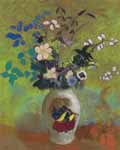
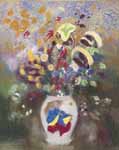
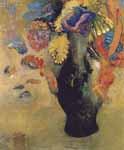

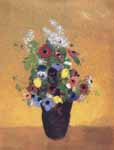


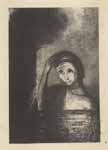
Frontispiece from Emile Verhaeren's Les Debacles
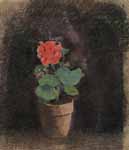

Geraniums and Other Flowers in a Vase
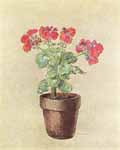
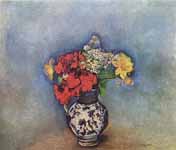
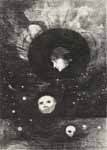
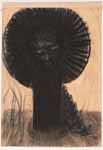
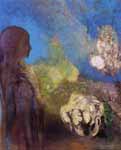
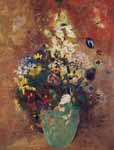
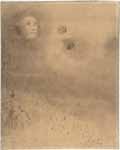
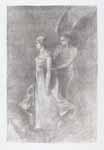


He Fixed His Eyes on Me with an Expression That Was So Strange

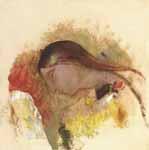
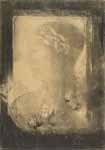
Head of a Woman with Flowers in Profile
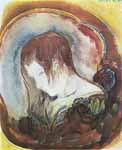
Head of a Woman with Head Bowed
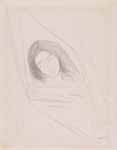

Head of a Young Woman in Profile
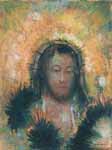
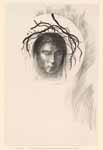
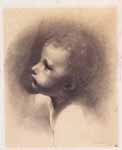
Head of Saint John the Baptist
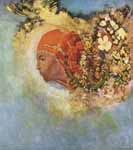
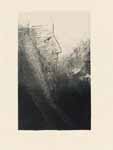
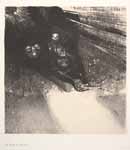



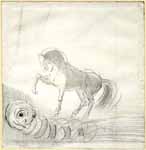
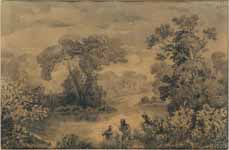
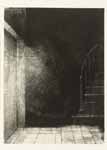
I Saw a Flash of Light, Large and Pale
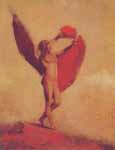
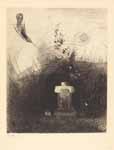
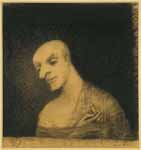
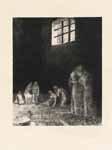
In the Shadow Are People, Weeping and Praying, Surrounded by Others Who Are Exhorting Them
 Initiation to Study Two Young Ladies
Initiation to Study Two Young Ladies
Odilon Redon : Part 1 : Part 2 : Part 3
Fine Art Prints | Greeting Cards | iPhone Cases | Tote Bags | Clothing | Lifestyle | Beach ...
Odilon Redon (born Bertrand-Jean Redon; French: [ʁədɔ̃]; April 20, 1840 – July 6, 1916) was a French symbolist painter, printmaker, draughtsman and pastellist.
Biography
Odilon Redon was born in Bordeaux, Aquitaine, to a prosperous family. The young Bertrand-Jean Redon acquired the nickname "Odilon" from his mother, Odile.[2] Redon started drawing as a child; and, at the age of ten, he was awarded a drawing prize at school. He began the formal study of drawing at fifteen; but, at his father's insistence, he changed to architecture. Failure to pass the entrance exams at Paris’ École des Beaux-Arts ended any plans for a career as an architect, although he briefly studied painting there under Jean-Léon Gérôme in 1864. (His younger brother Gaston Redon would become a noted architect.)
Back in his native Bordeaux, he took up sculpting, and Rodolphe Bresdin instructed him in etching and lithography. His artistic career was interrupted in 1870 when he joined the army to serve in the Franco-Prussian War.
At the end of the war, he moved to Paris and resumed working almost exclusively in charcoal and lithography. He called his visionary works, conceived in shades of black, his noirs. It was not until 1878 that his work gained any recognition with Guardian Spirit of the Waters; he published his first album of lithographs, titled Dans le Rêve, in 1879. Still, Redon remained relatively unknown until the appearance in 1884 of a cult novel by Joris-Karl Huysmans titled À rebours (Against Nature). The story featured a decadent aristocrat who collected Redon's drawings.
In the 1890s pastel and oils became his favored media; he produced no more noirs after 1900. In 1899, he exhibited with the Nabis at Durand-Ruel's.
Redon had a keen interest in Hindu and Buddhist religion and culture. The figure of the Buddha increasingly showed in his work. Influences of Japonism blended into his art, such as the painting The Death of the Buddha around 1899, The Buddha in 1906, Jacob and the Angel in 1905, and Vase with Japanese warrior in 1905, amongst many others.[3][4]
Baron Robert de Domecy (1867–1946) commissioned the artist in 1899 to create 17 decorative panels for the dining room of the Château de Domecy-sur-le-Vault near Sermizelles in Burgundy. Redon had created large decorative works for private residences in the past, but his compositions for the château de Domecy in 1900–1901 were his most radical compositions to that point and mark the transition from ornamental to abstract painting. The landscape details do not show a specific place or space. Only details of trees, twigs with leaves, and budding flowers in an endless horizon can be seen. The colours used are mostly yellow, grey, brown and light blue. The influence of the Japanese painting style found on folding screens byōbu is discernible in his choice of colours and the rectangular proportions of most of the up to 2.5 metres high panels. Fifteen of them are located today in the Musée d'Orsay, acquisitioned in 1988.[5]
Domecy also commissioned Redon to paint portraits of his wife and their daughter Jeanne, two of which are in the collections of the Musée d'Orsay and the Getty Museum in California.[6][7] Most of the paintings remained in the Domecy family collection until the 1960s.[8]
In 1903 Redon was awarded the Legion of Honor.[9] His popularity increased when a catalogue of etchings and lithographs was published by André Mellerio in 1913; that same year, he was given the largest single representation at the New York Armory Show.
Redon died on July 6, 1916. In 1923 Mellerio published Odilon Redon: Peintre Dessinateur et Graveur. An archive of Mellerio's papers is held by the Ryerson & Burnham Libraries at the Art Institute of Chicago.
In 2005 the Museum of Modern Art launched an exhibition entitled "Beyond The Visible", a comprehensive overview of Redon's work showcasing more than 100 paintings, drawings, prints and books from The Ian Woodner Family Collection. The exhibition ran from October 30, 2005 to January 23, 2006.[10]
The Fondation Beyeler in Basel, Switzerland is showing a retrospective from February to May 2014.[11]
Analysis of his work
Butterflies, around 1910 (Museum of Modern Art)
Redon's work represents an exploration of his internal feelings and psyche. He himself wanted to "place the visible at the service of the invisible"; thus, although his work seems filled with strange beings and grotesque dichotomies, his aim was to represent pictorially the ghosts of his own mind. A telling source of Redon's inspiration and the forces behind his works can be found in his journal A Soi-même (To Myself). His process was explained best by himself when he said:
"I have often, as an exercise and as a sustenance, painted before an object down to the smallest accidents of its visual appearance; but the day left me sad and with an unsatiated thirst. The next day I let the other source run, that of imagination, through the recollection of the forms and I was then reassured and appeased."
The mystery and the evocation of Redon's drawings are described by Huysmans in the following passage:
"Those were the pictures bearing the signature: Odilon Redon. They held, between their gold-edged frames of unpolished pearwood, undreamed-of images: a Merovingian-type head, resting upon a cup; a bearded man, reminiscent both of a Buddhist priest and a public orator, touching an enormous cannon-ball with his finger; a spider with a human face lodged in the centre of its body. Then there were charcoal sketches which delved even deeper into the terrors of fever-ridden dreams. Here, on an enormous die, a melancholy eyelid winked; over there stretched dry and arid landscapes, calcinated plains, heaving and quaking ground, where volcanos erupted into rebellious clouds, under foul and murky skies; sometimes the subjects seemed to have been taken from the nightmarish dreams of science, and hark back to prehistoric times; monstrous flora bloomed on the rocks; everywhere, in among the erratic blocks and glacial mud, were figures whose simian appearance—heavy jawbone, protruding brows, receding forehead, and flattened skull top—recalled the ancestral head, the head of the first Quaternary Period, the head of man when he was still fructivorous and without speech, the contemporary of the mammoth, of the rhinoceros with septate nostrils, and of the giant bear. These drawings defied classification; unheeding, for the most part, of the limitations of painting, they ushered in a very special type of the fantastic, one born of sickness and delirium."[12]
Redon also describes his work as ambiguous and undefinable:
"My drawings inspire, and are not to be defined. They place us, as does music, in the ambiguous realm of the undetermined."[13]
References
"Musée d'Orsay: non_traduit". Musee-orsay.fr. 1987-10-14. Retrieved 2015-03-09.
"Online Essay on Odilon Redon". Chez.com. Retrieved 10 October 2014.
"Odilon Redon (1840-1916) | Vase au guerrier japonais | IMPRESSIONIST & MODERN ART Auction | 20th Century, Drawings & Watercolors | Christie's". Christies.com. 2010-02-02. Retrieved 2015-03-09.
"Odilon Redon | Press Images - Fondation Beyeler". Pressimages.fondationbeyeler.ch. Retrieved 2015-03-09.
"Musee d'Orsay : Homepage". Musee-orsay.fr. Retrieved 2015-03-09.
"Musée d'Orsay: Odilon Redon Baroness Robert de Domecy". 4 February 2009. Retrieved 10 October 2014.
"Baronne de Domecy (Getty Museum)". Getty.edu. Retrieved 2015-03-09.
"Sotheby's Impressionist & Modern Art Evening Sale" (PDF). Sothebys.com. Retrieved 2015-03-09.
Redon and Werner (1969), p. ix.
Danielle O'Steen (November 2005). "Dark Dreamer". ART + AUCTION. Retrieved 2008-05-20.
"Introduction | Fondation Beyeler". Fondationbeyeler.ch. Retrieved 2015-03-09.
Huysmans, Joris-Karl (1998). Against Nature. Translated by Margaret Mauldon. Oxford University Press. pp. 52–53. ISBN 0-14-044086-0.
Goldwater, Robert; Treves, Marco (1945). Artists on Art. Pantheon. ISBN 0-394-70900-4.
Bibliography
Russell T. Clement, Four French Symbolists: A Sourcebook on Pierre Puvis de Chavannes, Gustave Moreau, Odilon Redon, and Maurice Denis, Greenwood Press, 1996, ISBN 0-313-29752-5 & ISBN 978-0-313-29752-6
Jodi Hauptman and Marina Van Zuylen, Beyond the Visible: The Art of Odilon Redon, 2005, ISBN 0-87070-702-7 & ISBN 978-0-87070-702-5
Andre Mellerio, Odilon Redon, 1968, ASIN B0007DNIKO
Odilon Redon and Alfred Werner, The Graphic Works of Odilon Redon, Dover, 1969, ISBN 0-486-21996-8
Odilon Redon and Alfred Werner, The Graphic Works of Odilon Redon, (Dover Pictorial Archive), 2005, ISBN 0-486-44659-X & ISBN 978-0-486-44659-2
Margret Stuffmann, Odilon Redon: As in a Dream, 2007, ISBN 3-7757-1894-X & ISBN 978-3-7757-1894-3
----
Fine Art Prints | Greeting Cards | Phone Cases | Lifestyle | Face Masks | Men's , Women' Apparel | Home Decor | jigsaw puzzles | Notebooks | Tapestries | ...
----
Artist
A - B - C - D - E - F - G - H - I - J - K - L - M -
N - O - P - Q - R - S - T - U - V - W - X - Y - Z
Retrieved from "http://en.wikipedia.org/"
All text is available under the terms of the GNU Free Documentation License






